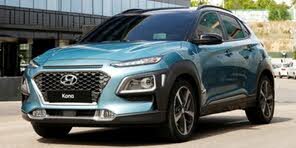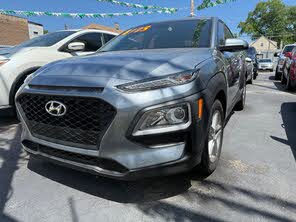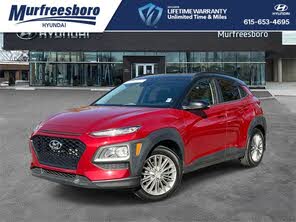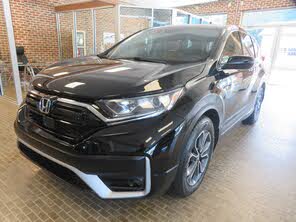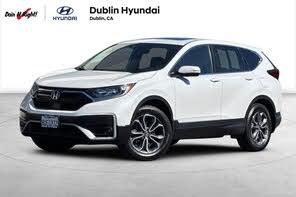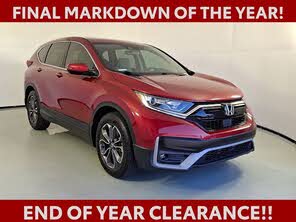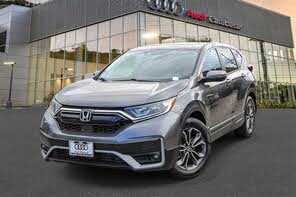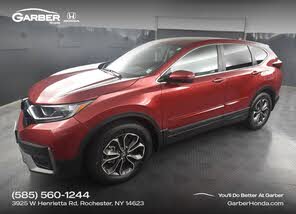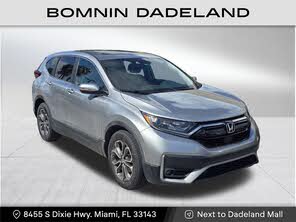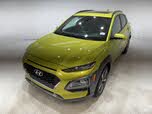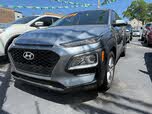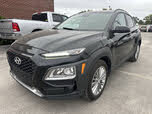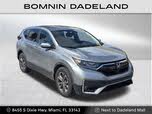2020 Hyundai Kona vs 2020 Honda CR-V
Overview | |
MSRP$20,300 | MSRP$25,150 |
Listings406 | Listings1672 |
Ratings & Reviews | |
User Reviews | User Reviews |
Expert reviews6.8 out of 10 | Expert reviews7.5 out of 10 |
Pros
Cons
| Pros
Cons
|
2020 Hyundai Kona Reviews SummaryThe Hyundai Kona subcompact SUV is one of the smallest cars you can buy with all-wheel drive. It competes in a class of four-door hatchbacks with the lifted suspensions and higher driving positions that crossover buyers want—and with the same generous list of convenience and safety features that come on larger crossovers. We last tested the Kona when it came out for 2018, but a new trim level and more standard driver assists are the major changes for 2020. For what Hyundai charges, the Kona is cramped and the interior disappoints, yet exterior style and on-road performance are spectacular. | |
2020 Honda CR-V Reviews SummaryHonda’s compact SUV has been satisfying buyers for more than two decades, with more than five million CR-V’s sold. Such a legacy means the CR-V has long had its wrinkles smoothed out into a comfortable and capable crossover package that’s only downside may be its sheer inoffensiveness. This year’s model gets engine and safety upgrades, which improve fuel economy and help to make Honda’s bestseller an even better value. | |
No video found | |
Popular Features & Specs | |
Engine2.0L 147 hp I4 | Engine1.5L 190 hp I4 |
Drive TrainFWD | Drive TrainFWD |
Seating Capacity5 | Seating Capacity5 |
Horsepower147 hp @ 6200 rpm | Horsepower190 hp @ 5600 rpm |
MPG City27 | MPG City28 |
MPG Highway33 | MPG Highway34 |
Engine | |
Engine Name2.0L 147 hp I4 | Engine Name1.5L 190 hp I4 |
Torque132 lb-ft @ 4500 rpm | Torque179 lb-ft @ 2000 rpm |
Horsepower147 hp @ 6200 rpm | Horsepower190 hp @ 5600 rpm |
DrivetrainFWD | DrivetrainFWD |
Fuel Economy | |
MPG City27 | MPG City28 |
MPG Highway33 | MPG Highway34 |
Interior | |
Seating Capacity5 | Seating Capacity5 |
Safety | |
Front Crash Overall5 | Front Crash Overall5 |
Side Crash Overall5 | Side Crash Overall5 |
Dimensions & Capacity | |
Cargo Space19.2 cu ft | Cargo Space39.2 cu ft |
Curb Weight2890 lbs | Curb Weight3337 lbs |
Height61.0 in | Height66.1 in |
Length164.0 in | Length182.1 in |
Width70.9 in | Width73.0 in |
Wheelbase102.4 in | Wheelbase104.8 in |
Maximum Payload1089 lbs | Maximum Payload1358 lbs |
Number of doors4 | Number of doors4 |
Maximum Towing Capacity | Maximum Towing Capacity1500 lbs |
Overview | ||
MSRP | $20,300 | $25,150 |
Listings | ||
Ratings & Reviews | ||
User reviews | ||
Expert reviews | 6.8 out of 10Read full review | 7.5 out of 10Read full review |
Pros & cons | Pros
Cons
| Pros
Cons
|
Summary | The Hyundai Kona subcompact SUV is one of the smallest cars you can buy with all-wheel drive. It competes in a class of four-door hatchbacks with the lifted suspensions and higher driving positions that crossover buyers want—and with the same generous list of convenience and safety features that come on larger crossovers. We last tested the Kona when it came out for 2018, but a new trim level and more standard driver assists are the major changes for 2020. For what Hyundai charges, the Kona is cramped and the interior disappoints, yet exterior style and on-road performance are spectacular. | Honda’s compact SUV has been satisfying buyers for more than two decades, with more than five million CR-V’s sold. Such a legacy means the CR-V has long had its wrinkles smoothed out into a comfortable and capable crossover package that’s only downside may be its sheer inoffensiveness. This year’s model gets engine and safety upgrades, which improve fuel economy and help to make Honda’s bestseller an even better value. |
Video | No video found | |
Popular Features & Specs | ||
Engine | 2.0L 147 hp I4 | 1.5L 190 hp I4 |
Drive Train | FWD | FWD |
Seating Capacity | 5 | 5 |
Horsepower | 147 hp @ 6200 rpm | 190 hp @ 5600 rpm |
MPG City | 27 | 28 |
MPG Highway | 33 | 34 |
Engine | ||
Engine Name | 2.0L 147 hp I4 | 1.5L 190 hp I4 |
Torque | 132 lb-ft @ 4500 rpm | 179 lb-ft @ 2000 rpm |
Horsepower | 147 hp @ 6200 rpm | 190 hp @ 5600 rpm |
Drivetrain | FWD | FWD |
Fuel Economy | ||
MPG City | 27 | 28 |
MPG Highway | 33 | 34 |
Interior | ||
Seating Capacity | 5 | 5 |
Safety | ||
Front Crash Overall | 5 | 5 |
Side Crash Overall | 5 | 5 |
Dimensions & Capacity | ||
Cargo Space | 19.2 cu ft | 39.2 cu ft |
Curb Weight | 2890 lbs | 3337 lbs |
Height | 61.0 in | 66.1 in |
Length | 164.0 in | 182.1 in |
Width | 70.9 in | 73.0 in |
Wheelbase | 102.4 in | 104.8 in |
Maximum Payload | 1089 lbs | 1358 lbs |
Number of doors | 4 | 4 |
Maximum Towing Capacity | 1500 lbs | |
The 2020 Hyundai Kona was celebrated for its dynamic and exciting exterior design, standing out clearly from its smaller, drabber competition like the Ford EcoSport. Sporting a longer, sleeker, and sportier build, the Kona leveraged its compact footprint to create a dramatic exterior design usually reserved for higher-end models. The designers utilized tiered lighting, a tall grille, and bold matte plastic trim to enhance its visual appeal, making the Kona appear taller and wider than its actual dimensions. Additional features like optional fog lights, fender creases, and two-tone wheels contributed to its premium vibe. Yet, the interior fell short of matching the vibrant exterior, plagued by hard plastics and lackluster finishes that contrasted sharply with its competitors like the Mazda CX-30, C-HR, and Honda HR-V.
On the other hand, the 2020 Honda CR-V's design was more familiar and approachable, leaning towards a soft, curvy, and car-like exterior that provided a modern family transport feel. Its resemblance to Honda's sedan lineup gave it a cohesive look. Inside, however, the CR-V exhibited a mix of high-quality materials with noticeable low-quality plastics, revealing its economical origins. Despite this, the CR-V maintained a sense of premium through wood-look trim and leather upholstery in higher trims. The simplistic approach in its design, highlighted by a limited number of trim levels and optional AWD, made it user-friendly and straightforward, albeit less dramatic than the Kona.











The 2020 Hyundai Kona delivered a surprisingly robust performance for its class. Powered by a 1.6-liter turbocharged inline-four engine in its Limited and Ultimate trims, it churned out 175 horsepower and 195 pound-feet of torque, offering exceptional acceleration and responsiveness. This power was efficiently managed by a 7-speed dual-clutch transmission that ensured a smooth and engaging driving experience, particularly in sport mode. However, the standard 2.0-liter inline-four with 147 hp and 132 lb-ft felt underwhelming compared to its turbocharged counterpart. Despite the Kona's adept handling and quick steering, it was hampered by a stiffer ride and higher cabin noise compared to competitors like the Honda HR-V and Mazda CX-30. The fuel economy was decent but not exceptional, with AWD models averaging around 29 mpg.
In comparison, the 2020 Honda CR-V featured a singular 1.5-liter turbocharged engine across all trims, producing 190 horsepower and 179 pound-feet of torque. Mated to a CVT, the engine offered smooth and efficient power delivery, especially notable in sport mode. The CR-V's driving experience was akin to a small sedan, with nimble handling and a comfortable, well-balanced ride. One standout feature was its fuel economy, with FWD models achieving up to 30 mpg combined, making it one of the most efficient in its class. This level of refinement and efficiency was a significant plus for the CR-V, positioning it well against its peers.
When it came to practicality, the 2020 Hyundai Kona struggled, especially concerning cargo space. With just 19 cubic feet of storage behind the rear seats and 46 cubic feet with seats folded, it lagged behind most competitors. The rear seating arrangement accommodated average-sized adults, but taller passengers might find the space restrictive. This limitation made it less versatile for family or cargo-heavy use, detracting from its utility credentials.
The 2020 Honda CR-V, however, excelled in practicality and space utilization. Honda's renowned packaging efficiency was evident, offering ample head and legroom for both front and rear passengers. The CR-V boasted a cavernous cargo space of 75.8 cubic feet with the rear seats folded down, surpassing many of its rivals. The well-thought-out interior featured clever storage solutions, such as a versatile center console and a two-position load floor, enhancing its everyday usability. These features made the CR-V a prime choice for families in need of spacious and versatile transport.
The 2020 Hyundai Kona provided an impressive array of technological features, particularly in trims above the base SE. Standard features included a 7-inch touchscreen with Apple CarPlay and Android Auto, with higher trims offering proximity entry, heated seats, and advanced connectivity options through Blue Link. The range-topping Ultimate trim came with an 8-inch touchscreen, navigation, and adaptive cruise control. However, some key amenities like lane-centering were absent in the base models.
Conversely, the 2020 Honda CR-V showed its age with its outdated infotainment system. The base LX trim featured an inadequate 5-inch screen, while higher trims offered a modest 7-inch touchscreen with Apple CarPlay and Android Auto. The infotainment interface was cumbersome, lacking hard buttons and requiring multiple taps to operate effectively. Despite offering numerous USB ports and a wireless charging option in the Touring trim, the CR-V's tech suite felt outdated compared to rivals.
Safety was a strong point for both vehicles. The 2020 Hyundai Kona earned top marks from both NHTSA and IIHS, demonstrating excellent crash test performance and high ratings for forward emergency braking. Standard safety features included lane-keep assist and a driver attention monitor, with pedestrian detection available only in the Ultimate trim. The absence of front knee airbags and rear side airbags, however, was a notable omission.
The 2020 Honda CR-V also excelled in safety, equipped with the comprehensive Honda Sensing suite as standard across all trims. This included forward-collision warning, automatic emergency braking, pedestrian detection, and adaptive cruise control. It also received top safety ratings from NHTSA and IIHS, although non-Touring trims suffered due to subpar halogen headlights. Overall, the CR-V provided a slightly more robust safety offering.
CarGurus highlights
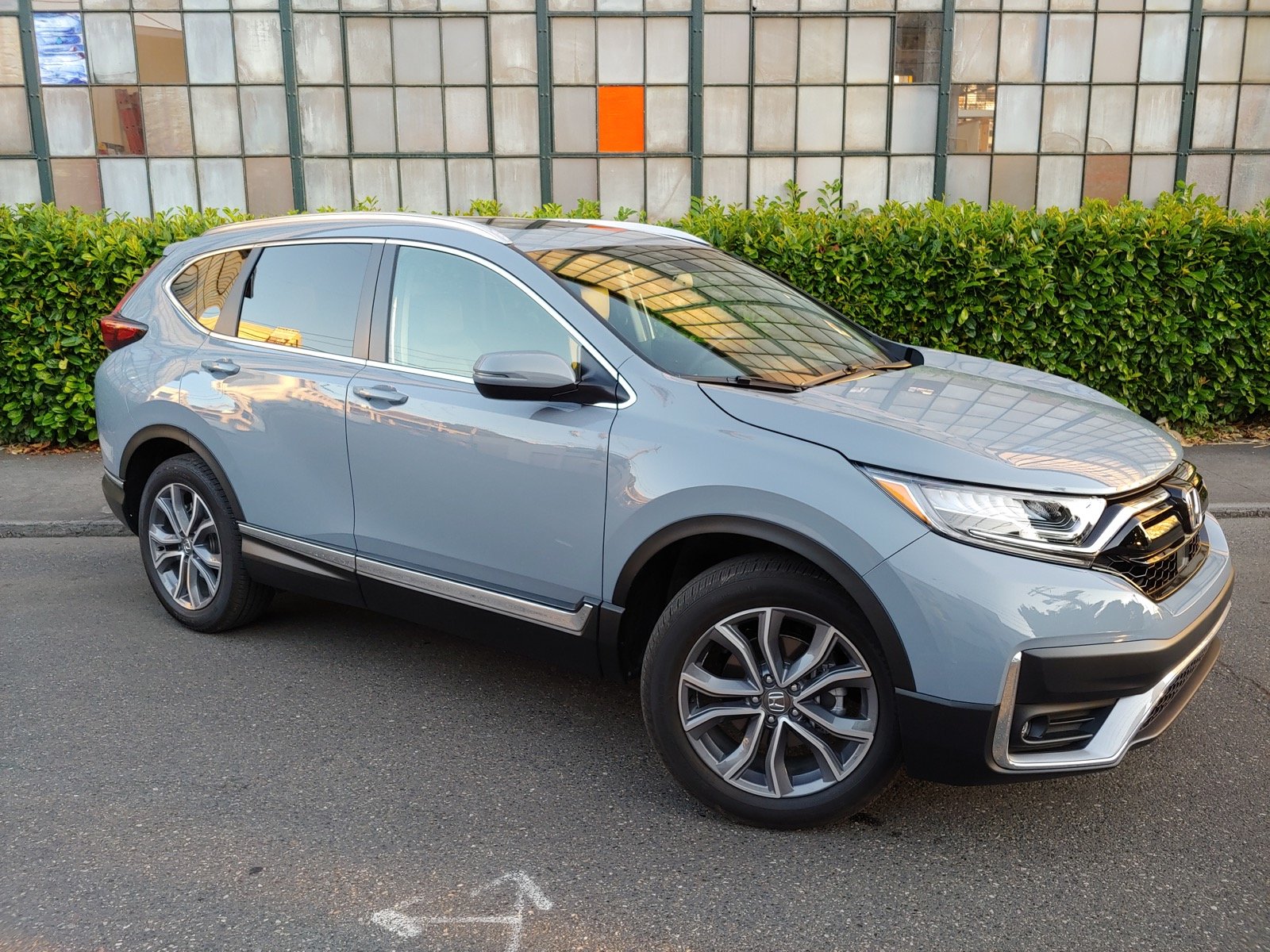
According to CarGurus experts, the overall rating for the 2020 Hyundai Kona is 6.8 out of 10, while the 2020 Honda CR-V scores 7.5 out of 10. While the Hyundai Kona stands out with its exciting design and strong turbocharged performance, the Honda CR-V ultimately provides a more well-rounded package. Its spacious interior, better fuel economy, and comprehensive safety features make it a superior choice for most consumers. Therefore, my final recommendation, based on these ratings, is to choose the 2020 Honda CR-V.
Choose the 2020 Hyundai Kona if:
- You prioritize a dynamic and sporty exterior design that stands out in the compact SUV segment.
- You seek strong turbocharged engine performance and responsive handling, especially in limited and ultimate trims.
- You desire a modern infotainment system with good standard features and connectivity options.
Choose the 2020 Honda CR-V if:
- You need a spacious and practical cabin with excellent cargo capacity for family and recreational use.
- You value higher fuel efficiency and a comfortable, well-balanced driving experience.
- You prefer a comprehensive suite of standard safety features across all trims, ensuring peace of mind on the road.
CarGurus highlights

According to CarGurus experts, the overall rating for the 2020 Hyundai Kona is 6.8 out of 10, while the 2020 Honda CR-V scores 7.5 out of 10. While the Hyundai Kona stands out with its exciting design and strong turbocharged performance, the Honda CR-V ultimately provides a more well-rounded package. Its spacious interior, better fuel economy, and comprehensive safety features make it a superior choice for most consumers. Therefore, my final recommendation, based on these ratings, is to choose the 2020 Honda CR-V.
Choose the 2020 Hyundai Kona if:
Shop Now- You prioritize a dynamic and sporty exterior design that stands out in the compact SUV segment.
- You seek strong turbocharged engine performance and responsive handling, especially in limited and ultimate trims.
- You desire a modern infotainment system with good standard features and connectivity options.
Choose the 2020 Honda CR-V if:
Shop Now- You need a spacious and practical cabin with excellent cargo capacity for family and recreational use.
- You value higher fuel efficiency and a comfortable, well-balanced driving experience.
- You prefer a comprehensive suite of standard safety features across all trims, ensuring peace of mind on the road.

By: CarGurus + AI
At CarGurus, our team of experienced automotive writers remain at the heart of our content operation, conducting hands-on car tests and writing insightful guides that are backed by years of industry experience. To complement this, we are harnessing AI to make our content offering more diverse and more helpful to shoppers than ever. To achieve this, our AI systems are based exclusively on CarGurus content, ratings and data, so that what we produce is both unique to CarGurus, and uniquely helpful to car shoppers.




